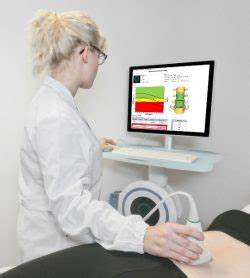There’s a new kid in town, but it seems not too many people have heard about it. In 2018, the FDA approved a new way of determining bone density: radiofrequency echographic multi spectrometry (REMS), more commonly known by the company that manufactures it, Echolight.
Developed in Italy and widely used throughout Europe, the Echolight machine uses ultrasound to measure bone density at the hip and spine. The research so far is very promising. Reports indicate that the results are accurate and compare very favorably with the results from currently used DXA machines. Not only is there no radiation, but the results are available within minutes and the presence of “artifacts”, (total hip replacement hardware, for example), do not interfere with the test.
So why does this seem to be a ‘best kept secret’? It could be that more research needs to be done to have this become more mainstream in our country. Perhaps, unsurprisingly, money is also a consideration. Hospitals that have spent thousands of dollars on DXA machines and related TBS software, (more on that below), might be reluctant to switch to this newer technology. Nevertheless, I wouldn’t be surprised if we begin to see Echolight machines pop up in doctor’s offices – they’re portable, cheaper, easier to use, and quick.
Update on the Trabecular Bone Score (TBS):
In the most recent issue of the National Women’s Health Network newsletter, (link below), Cynthia Pearson, formerly the executive director, discussed the Trabecular Bone Score (TBS) in an article titled “Strong Bones or Heavy Bones? Let’s Find Out.” Cindy writes about how her participation in the “Taking Charge of Your Bone Health” webinar that Shelley Zeichner and I offered in October 2020, inspired her to do a “deep dive” into TBS technology. It’s an informative read, and we were very honored to be acknowledged in the article.
Moreover, as a result of the grassroots demands for more accurate testing for osteoporosis that we are proud to be part of, TBS testing will be now be covered by insurance companies beginning in January 2022!
In good health, always,
Joanne
References
Pearson, C.A. Strong Bones or Heavy Bones? Let’s Find Out. The Women’s
Health Activist 2021; 46:4. (View PDF)
Adami, G., et al. Radiofrequency Echographic Multi Spectrometry for the Prediction of Incident Fragility Fractures: A 5-year Follow-up Study. Bone 2020; 134:115297. (PubMed, View PDF)
Conversano F, et al. A Novel Ultrasound Methodology for Estimating Spine Mineral Density. Ultrasound in Medicine & Biology 2015 January;41 (1):281-300. (PubMed)
Cortet B, et al. Radiofrequency Echographic Multi Spectrometry (REMS) for the Diagnosis of Osteoporosis in a European Multicenter Clinical Context. Bone 2021 Feb;143:115786. (PubMed)
Di Paola, M., et al. 2019. Radiofrequency Echographic Multispectrometry Compared with Dual X-ray Absorptiometry for Osteoporosis Diagnosis on Lumbar Spine and Femoral Neck. Osteoporosis International 2019 Feb;30(2):391-402. (PubMed)

